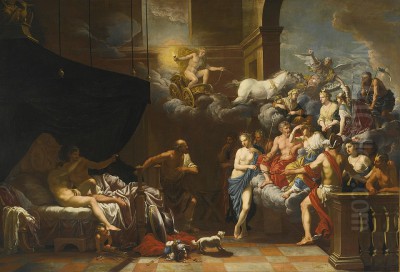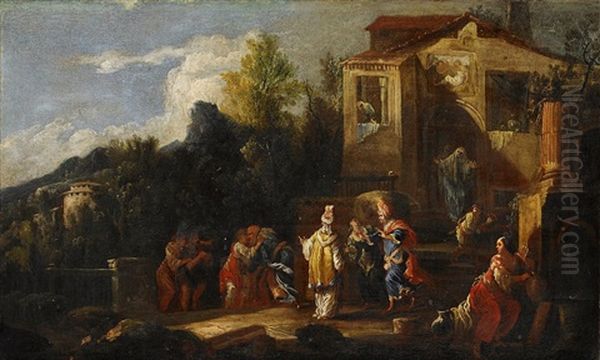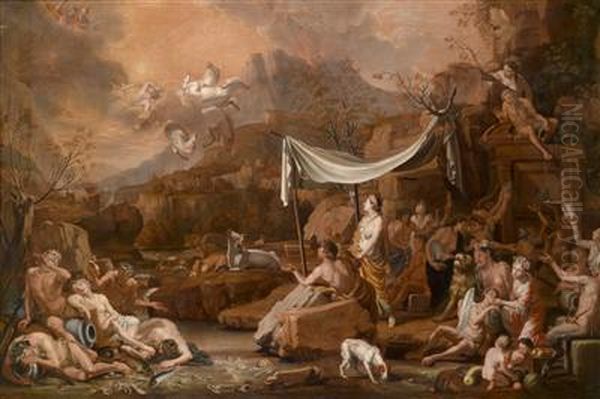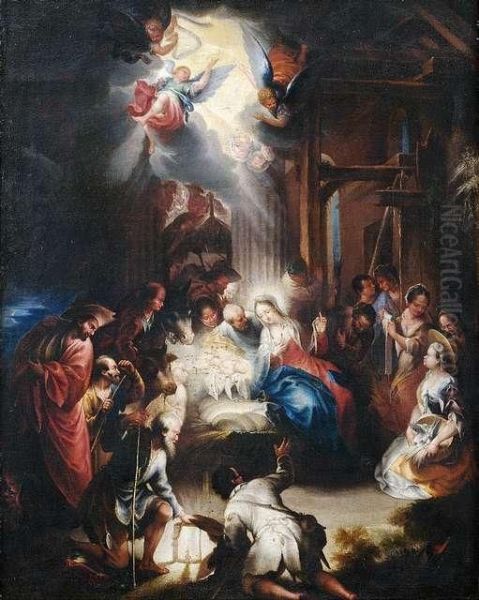
Johann Heiss stands as a significant figure in the landscape of German Baroque art. Active during the latter half of the 17th century, he carved a niche for himself primarily in the thriving Imperial Free City of Augsburg. Born in Memmingen in 1640 and passing away in Augsburg in 1704, Heiss navigated a period of artistic transition and recovery in the German-speaking lands following the devastation of the Thirty Years' War. His oeuvre, characterized by historical, mythological, and allegorical themes, reflects both the enduring influence of Italian masters and the distinct artistic currents flowing through Southern Germany during his time. He became renowned for his complex, multi-figure compositions and his ability to weave intricate narratives into visually compelling canvases.
Early Life and Artistic Formation
Johann Heiss's artistic journey began in his birthplace, Memmingen, a Swabian town not far from Augsburg. His initial training was under the guidance of Johann Friedrich Sichelbein (or Sichelbein the Elder), a member of a notable family of painters active in the region. This early instruction would have provided Heiss with a foundational understanding of painting techniques and the prevailing artistic tastes of the area. However, his artistic development took a decisive turn when he moved to Augsburg, a major artistic and cultural hub.
In Augsburg, Heiss entered the workshop of Johann Heinrich Schönfeld (c. 1609–c. 1684). This apprenticeship proved crucial. Schönfeld, who had spent considerable time in Italy, particularly in Rome and Naples, brought a sophisticated, internationally informed style back to Germany. He was known for his elongated figures, dramatic lighting often influenced by Neapolitan tenebrism, and a penchant for historical and mythological subjects drawn from classical antiquity. Schönfeld's impact on Heiss was profound, shaping his thematic preferences and influencing his approach to composition and atmosphere.
The Augsburg Context: A Flourishing Art Center

To fully appreciate Johann Heiss's career, one must understand the environment of Augsburg in the late 17th century. Despite the lingering effects of the Thirty Years' War, Augsburg remained a vital center for commerce, printing, finance, and the arts. As an Imperial Free City, it enjoyed a degree of autonomy and fostered a prosperous merchant class alongside established noble families, creating a diverse base for artistic patronage. The city was particularly renowned for its goldsmiths and engravers, indicating a high level of craftsmanship and aesthetic appreciation.
This environment provided fertile ground for artists like Heiss and his master Schönfeld. The demand for paintings to adorn civic buildings, private residences, and potentially churches, fueled artistic production. Augsburg's strong tradition in printmaking also meant that artists' designs could be disseminated more widely, enhancing their reputation. Heiss operated within this dynamic milieu, contributing to Augsburg's reputation as a leading center for painting in Southern Germany during the latter half of the 17th century, rivaling even Munich in certain aspects.
Artistic Style: A Synthesis of Influences
Johann Heiss developed a distinctive style that skillfully blended various European artistic traditions, primarily those of Italy and, to some extent, France, adapted to a German context. His works are often characterized by a certain theatricality, dynamic compositions, and a rich, though sometimes cool, color palette.
Italian Echoes: Venice and Beyond
The influence of Italian art, particularly the Venetian school of the High Renaissance and early Baroque, is palpable in Heiss's work. Artists like Paolo Veronese (1528–1588) and Jacopo Tintoretto (1518–1594) seem to have left their mark. From Veronese, Heiss appears to have absorbed a love for grand, populous scenes, often set within elaborate architectural frameworks, and a vibrant use of color to define form and create spectacle. The bustling energy and narrative complexity found in many of Heiss's multi-figure compositions recall Veronese's large-scale historical and allegorical paintings.
From Tintoretto, Heiss may have drawn inspiration for dramatic lighting effects (chiaroscuro) and dynamic, sometimes diagonal, compositional structures that infuse his scenes with energy and movement. While Heiss's lighting is not typically as starkly contrasted as that of Caravaggio (1571–1610), the interplay of light and shadow is consistently used to model figures, create depth, and heighten emotional impact. Some scholars speculate, based on stylistic evidence like the inclusion of Italianate landscapes and architecture, that Heiss may have travelled to Italy himself, though concrete documentary proof remains elusive. Regardless, the spirit of Italian Baroque drama permeates his work.
French Classicism and Structure

Alongside the dynamism derived from Italy, elements associated with French Baroque classicism, particularly the influence of Nicolas Poussin (1594–1665), can be discerned in Heiss's art. Poussin championed clarity, order, and intellectual rigor in painting, often structuring his complex historical and mythological scenes with a strong sense of compositional logic and archaeological accuracy.
In Heiss's work, this influence manifests perhaps less in overt classicizing forms and more in the careful arrangement of figures and the clear articulation of the narrative, even within crowded scenes. While embracing Baroque movement and emotion, Heiss often maintains a degree of compositional stability and legibility that prevents his works from dissolving into chaos. This suggests an awareness of, or perhaps an indirect absorption of, the principles valued by Poussin and other French contemporaries like Charles Le Brun (1619–1690), who organized vast artistic projects under Louis XIV.
A Unique Synthesis
Heiss was not merely an imitator; he forged these diverse influences into a personal style. His figures, while sometimes echoing Schönfeld's elongated elegance, often possess a solidity and presence of their own. He excelled at depicting rich textiles, gleaming armor, and expressive physiognomies. His compositions are typically well-balanced, guiding the viewer's eye through the unfolding story. He adapted the grandeur of the Italian Baroque and the structure of French classicism to suit the tastes of his German patrons, creating works that were both sophisticated and accessible.
Major Themes and Representative Works
Johann Heiss primarily focused on history painting, encompassing biblical scenes, episodes from classical mythology, and allegorical subjects. These genres were highly esteemed in the academic tradition of the time, allowing artists to demonstrate their erudition and skill in depicting complex human interactions and emotions.
Biblical Narratives
Heiss frequently turned to the Bible for subject matter. One of his notable works is The Finding of Moses (1696), now housed in the Museum im Schottenstift in Vienna. This painting depicts the well-known Old Testament story of Pharaoh's daughter discovering the infant Moses among the reeds. Heiss presents the scene with a characteristic richness of detail, focusing on the interactions between the elegantly attired princess and her attendants, set against a lush landscape backdrop. The composition is carefully arranged, leading the eye towards the central figures and the infant Moses.

Another biblical theme he explored is The Return of the Prodigal Son, a version of which is also found in the Schottenstift collection. This parable offered ample opportunity for depicting human emotion – repentance, forgiveness, and familial reunion – themes well-suited to the expressive potential of Baroque art. Heiss likely rendered this scene with the pathos and narrative clarity expected of such subjects. The Circle of the Holy Child series (circa 1676), also in Vienna, further demonstrates his engagement with religious themes, likely depicting scenes centered around the infant Christ and the Holy Family.
Mythological and Classical History
Mythology provided Heiss with a vast repertoire of dramatic stories and opportunities for depicting the human form in various states of action and emotion. Ovid's Metamorphoses was a particularly rich source for Baroque artists. A powerful example of Heiss's work in this genre is The Fall of Phaeton. This subject, depicting the disastrous attempt of Apollo's son to drive the sun chariot, allowed Heiss to showcase his ability to render dynamic movement, dramatic foreshortening, and intense emotion as Phaeton plunges from the sky, horses rearing in chaos.
Heiss also painted scenes from ancient history, which often carried allegorical or moralizing undertones. His depictions of figures like Alexander the Great or scenes from Roman history would have appealed to patrons interested in classical learning and examples of virtue or vice. These works allowed for the display of historical detail in costumes and settings, further demonstrating the artist's skill and knowledge.
Allegory
Allegorical paintings, which convey abstract concepts or moral messages through symbolic figures and narratives, were another significant part of Heiss's output. Allegory of Good Government is a prime example. Such works were often commissioned for civic settings or by rulers to promote specific virtues or political ideas. In this painting, Heiss likely employed personifications – figures representing concepts like Justice, Prudence, or Peace – interacting with rulers or symbolic representations of the state. These complex compositions required viewers to decipher the intricate web of symbols, reflecting the intellectual preoccupations of the Baroque era. Heiss's skill in organizing multiple figures and imbuing them with clear symbolic meaning made him adept at this demanding genre.
Heiss as Engraver and Designer
Beyond his significant output as a painter, Johann Heiss also engaged in printmaking, working as an engraver. While perhaps less known for his prints than for his paintings, this activity was common for artists of the period. Engraving allowed for the wider reproduction and dissemination of designs, reaching a broader audience than unique paintings could. Heiss produced engravings based on historical subjects, likely including his own compositions as well as potentially those of other artists.
His talents extended to design work as well. A notable example is his collaboration with the engraver Bartholomew Kilian (likely Bartholomäus II Kilian, 1630–1696, a prominent member of a famous Augsburg family of engravers). Together, they designed a label for the Franceschi family, possibly merchants or producers of goods requiring sophisticated branding. This commission highlights Heiss's versatility and his integration into Augsburg's commercial and artistic networks, where painting, engraving, and design often intersected.
Contemporaries, Recognition, and Patronage
Johann Heiss operated within a network of artists and patrons. His most significant artistic relationship was undoubtedly with his teacher, Johann Heinrich Schönfeld, who remained a leading figure in Augsburg throughout much of Heiss's career. Together, they are often considered the principal masters of the Augsburg school of painting in their time.
Heiss achieved considerable recognition during his lifetime. The influential artist and art historian Joachim von Sandrart (1606–1688), in his important biographical dictionary Teutsche Academie der Edlen Bau-, Bild- und Mahlerey-Künste (German Academy of the Noble Architectonic, Sculptural and Pictorial Arts), specifically mentioned Heiss, praising his work. Such inclusion in a major contemporary survey of German art underscores Heiss's standing.
His patrons likely included the wealthy burghers and nobility of Augsburg and beyond. The presence of his works in collections associated with the Bavarian Electors in Munich indicates patronage at the highest levels of regional power. His paintings entered prestigious collections, and today can be found in major museums such as the Alte Pinakothek in Munich, the Herzog Anton Ulrich Museum in Braunschweig, the Westphalian State Museum in Münster, and the aforementioned Museum im Schottenstift in Vienna, testifying to their enduring appeal and historical importance.
While direct collaborations beyond the Kilian design project are not extensively documented, Heiss would have been aware of the broader European art scene. The works of Flemish masters like Peter Paul Rubens (1577–1640) and Anthony van Dyck (1599–1641), though preceding his main period of activity, had set a high bar for Baroque history painting across Europe. Even the powerful realism of Rembrandt (1606–1669) in the Netherlands formed part of the complex artistic backdrop against which German artists like Heiss worked, absorbing and transforming international trends. Heiss stands alongside other notable German Baroque painters like Michael Willmann (1630-1706) in Silesia, each contributing to the richness and diversity of art in the Holy Roman Empire during this period.
Later Career and Legacy
Johann Heiss remained active in Augsburg until his death in 1704. By the later stages of his career, he was an established and respected master within the city's artistic community. His consistent production of high-quality history paintings solidified his reputation. He likely ran a workshop and may have trained pupils, thus passing on his skills and style, although specific names of prominent students are not widely recorded.
His legacy lies in his contribution to the German Baroque, particularly within the context of the Augsburg school. He successfully synthesized Italian and French influences with a German sensibility, creating works that were both dramatic and compositionally sound. He demonstrated that German artists could master the prestigious genre of history painting, competing effectively within the broader European artistic landscape of the time.
Heiss represents a crucial link in the development of painting in Southern Germany. He absorbed the lessons of the previous generation, particularly Schönfeld, and developed his own robust style that maintained its relevance into the early 18th century. His work provides valuable insight into the artistic tastes, cultural preoccupations, and patronage systems of late 17th-century Augsburg. While perhaps not as revolutionary as some of his Italian or Dutch contemporaries, Johann Heiss was a highly skilled and significant painter whose works continue to be appreciated for their narrative power, technical proficiency, and historical importance.
Conclusion
Johann Heiss emerges from the annals of art history as a pivotal figure in the Augsburg school and a master of the German Baroque. His life and work reflect the complex interplay of local traditions and international influences that characterized European art in the 17th century. Through his skillful handling of historical, mythological, and allegorical themes, his dynamic compositions, and his synthesis of Italianate drama and French structure, Heiss created a significant body of work that earned him recognition in his own time and secures his place in the history of German art. His paintings, housed today in museums across Europe, stand as testaments to his talent and to the vibrant artistic culture of Augsburg during the Baroque era.